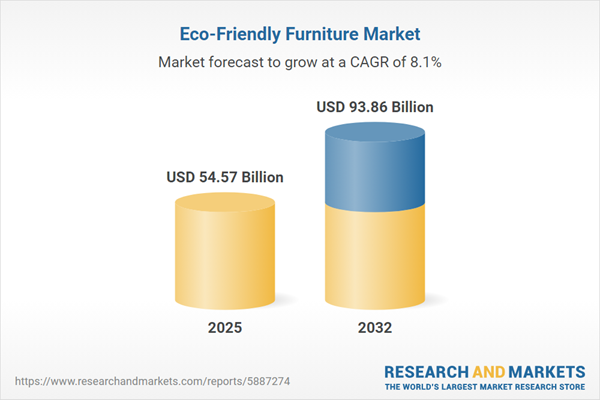Speak directly to the analyst to clarify any post sales queries you may have.
The eco-friendly furniture market is rapidly transforming procurement and supply strategies, presenting senior decision-makers with clear pathways to sustainable growth, regulatory compliance, and elevated stakeholder value. Organizations are proactively reshaping sourcing and supply networks to adapt to new priorities and requirements within this expanding sector.
Market Snapshot: Eco-Friendly Furniture Market Size and Trends
The global eco-friendly furniture market continues to expand steadily, reaching USD 50.44 billion in 2024 and projected to achieve USD 54.57 billion in 2025. The market is forecast to grow at an 8.07% CAGR, anticipated to reach USD 93.86 billion by 2032. This momentum is driven by widespread adoption of circular economy principles, enhanced product traceability, and increased emphasis on selecting responsible materials. Furthermore, commercial and residential market segments are both contributing to growth as leaders prioritize sustainable procurement and consider complete product lifecycles in differentiation strategies. Strengthened regulatory standards and environmental credentials are shaping enterprise and household procurement and influencing purchasing decisions globally.
Scope & Segmentation of the Eco-Friendly Furniture Market
This comprehensive analysis covers the main segments and operational dynamics critical for investment and procurement strategy in the eco-friendly furniture market. It provides insights into the technologies and regional approaches enabling agile adaptation to evolving sustainability demands and compliance measures.
- Product Types: Beds, cabinets, chairs, sofas, and tables are key categories targeted at both commercial and residential environments.
- Material Types: Renewable resources such as bamboo, metal, rattan, and recycled wood are prioritized to align with sustainability mandates and regulatory expectations.
- Sales Channels: Access to the market is enabled through offline furniture outlets, hypermarkets, specialty stores, supermarkets, and online platforms that support omnichannel distribution models.
- End Users: Major procurement is led by hospitality, institutional, office, and household sectors, each presenting unique drivers and compliance requirements.
- Distribution Channels: The market leverages direct sales, distributor networks, retail collaborations, and wholesale partnerships, supporting a flexible go-to-market strategy.
- Price Ranges: Offerings encompass economy, midrange, premium, and luxury categories to accommodate varying budget and project specifications.
- Applications: Eco-friendly furniture is designed for indoor settings such as bedrooms, offices, living rooms, dining areas, as well as outdoor spaces including patios, balconies, and gardens.
- Styles: Available designs cover contemporary, modern, rustic, and traditional aesthetics, addressing both international buyer intent and diverse local preferences.
- Regions: The report includes detailed analysis across the Americas, Europe, Middle East & Africa, and Asia-Pacific, noting adoption patterns and market-specific trends.
Key Takeaways for Senior Procurement and Sourcing Leaders
- Procurement teams are focusing on renewable and ethically sourced materials to build lasting stakeholder value and greater supply chain integrity.
- Increasingly complex regulatory frameworks and emerging international standards are prompting organizations to modernize operating models and invest in eco-focused technologies for ongoing compliance.
- Interdisciplinary collaboration across design, materials science, and logistics is enabling the development of modular solutions that meet both operational efficiency and eco-responsibility criteria.
- Digitally enabled procurement channels, offering customizable solutions and real-time traceability, are streamlining purchasing and bolstering transparency and trust with stakeholders.
- Industry-wide certifications, advanced recycling programs, and robust end-of-life strategies are increasingly recognized as key differentiators for institutional buyers and support brand positioning.
- Execution strategies exhibit strong regional focus: Europe emphasizes producer responsibility, the Middle East prioritizes homegrown sourcing, Africa advances via experimental initiatives, and Asia-Pacific leads in the adoption of innovative materials.
Tariff Impact: Strategic Adjustments Amid U.S. Trade Measures
The implementation of new U.S. tariffs in 2025 has led furniture organizations to reassess supplier bases and refine their cost management. These changes have spurred growth in nearshoring practices, a shift to alternative materials, and expanded investment in domestic processing. These moves support product innovation, enhance supply chain resilience, and help companies maintain alignment with evolving U.S. trade and environmental policies.
Methodology & Data Sources
The report integrates a rigorous secondary review of global industry standards, regulatory documents, and trade policies. In-depth interviews with supply chain experts and organizational decision-makers augment findings. Triangulation across sales data, compliance inputs, and workshop results ensures data accuracy and analytical integrity for key market participants.
Why This Report Matters
- Delivers clear segmentation and actionable analysis, enabling senior leaders to identify priority segments and streamline procurement planning for growth.
- Clarifies key regulatory shifts and trade impacts, informing risk management and supplier diversification strategies that reinforce operational resilience.
- Supports investments in digital solutions and sustainable design initiatives, aligning organizational objectives with changing market dynamics and stakeholder demands.
Conclusion
With its foundation in sustainability and innovation, the eco-friendly furniture market empowers organizations to pursue robust sourcing strategies that foster ongoing business development and reinforce stakeholder trust.
Additional Product Information:
- Purchase of this report includes 1 year online access with quarterly updates.
- This report can be updated on request. Please contact our Customer Experience team using the Ask a Question widget on our website.
Table of Contents
3. Executive Summary
4. Market Overview
7. Cumulative Impact of Artificial Intelligence 2025
Samples

LOADING...
Companies Mentioned
The key companies profiled in this Eco-Friendly Furniture market report include:- Ingka Holding B.V.
- Ashley Furniture Industries, LLC
- MillerKnoll, Inc.
- Steelcase Inc.
- Ethan Allen Interiors Inc.
- Haworth, Inc.
- Teknion Corporation
- Bassett Furniture Industries, Inc.
- Flexsteel Industries, Inc.
Table Information
| Report Attribute | Details |
|---|---|
| No. of Pages | 196 |
| Published | October 2025 |
| Forecast Period | 2025 - 2032 |
| Estimated Market Value ( USD | $ 54.57 Billion |
| Forecasted Market Value ( USD | $ 93.86 Billion |
| Compound Annual Growth Rate | 8.0% |
| Regions Covered | Global |
| No. of Companies Mentioned | 10 |









